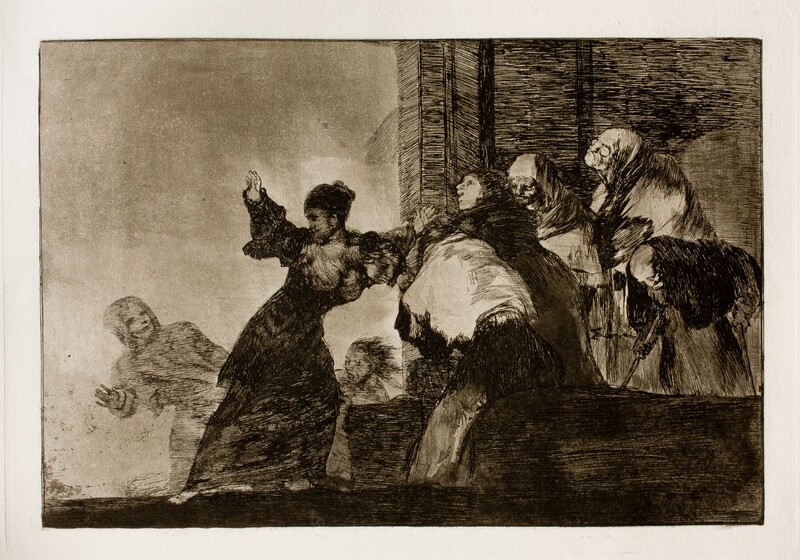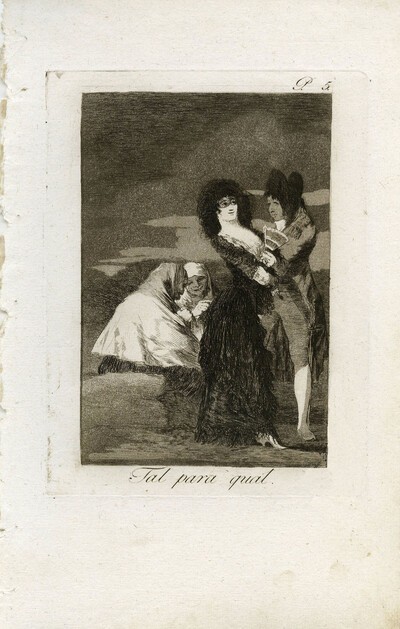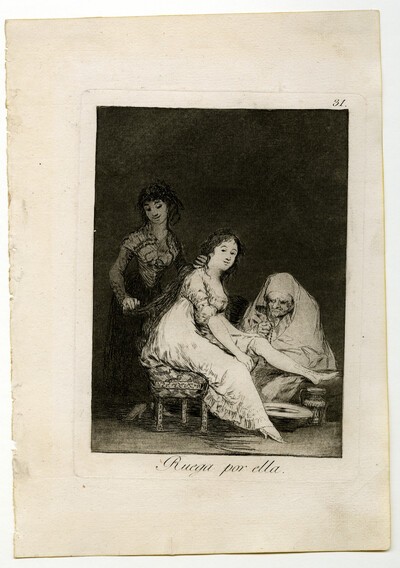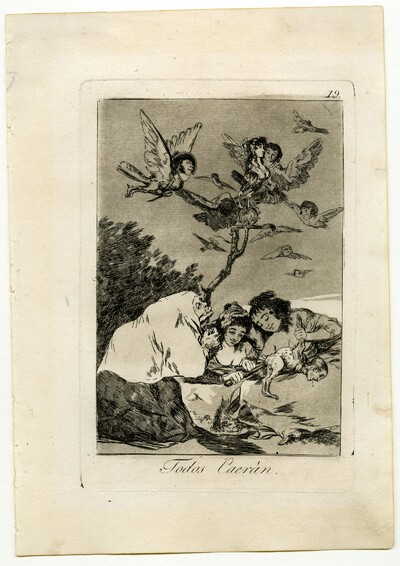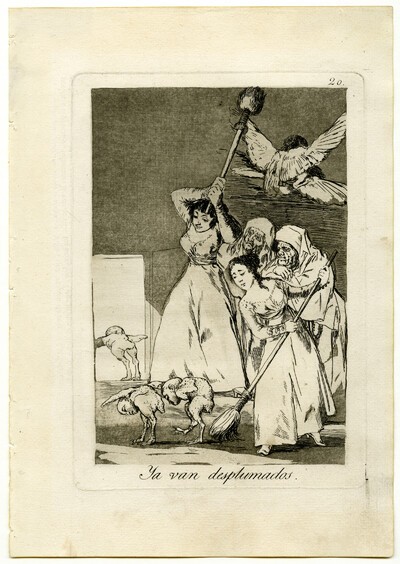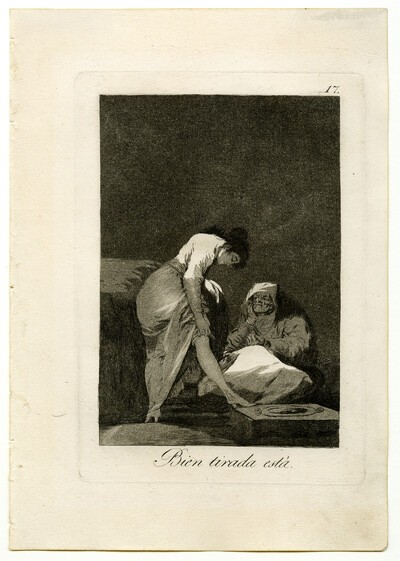- Cronología
- 1815 - 1819
- Dimensiones
- 247 x 358 mm
- Técnica y soporte
- Aguafuerte, aguatinta bruñida, punta seca y buril
- Reconocimiento de la autoría de Goya
- Documented work
- Ficha: realización/revisión
- 21 Aug 2021 / 05 Jun 2023
- Inventario
- -
See Femenine folly.
The state proof before the aquatint in the Lazaro Galdiano Foundation in Madrid has the handwritten number 14 in the upper left-hand corner. Another proof that belonged to the Sánchez Gerona collection bears the handwritten legend Poor folly.
This scene takes place under an architectural element, perhaps an atrium or portico of a church, in which six old women are sheltered, dressed in broad robes and wearing headdresses that cover their heads. One of them, as if lost in thought, wears spectacles. Beside her, another, bent over, leans on a cane, a touching representation of a helpless old woman. An attractive young girl with a complex attitude rushes towards them, her arms outstretched. An enigmatic character that makes this picture incomprehensible. Two heads protrude from her chest. One looks back with nostalgia, the other, with anguish, addresses the old women. The mystery is accentuated by the two figures in the background who seem to be chasing the young woman. One of them has a calm and tranquil demeanour, while the other has an unhinged expression, with a disfigured face and bristling hair. These latter figures are technically represented in a different way from the rest, as they are executed using very clear, light lines. Possibly they remain in the memory or in the past of the protagonist, which is why one of her heads is turned in remembrance of them. In the same image, reality and evocation are mixed.
The title of the print may be related to its meaning, as we may be looking at a group of beggars, towards whom the woman runs to take refuge in a sacred place. On the other hand, they may not be beggars, but rather matchmakers who are trying to convince the girl to become a prostitute. In fact, the way in which they are depicted closely resembles that of the celestinas who abound in the Caprices (Caprice 20. They are already plucked). Likewise, the girl is dressed in the same way as the prostitutes in the same series, insinuating her feminine curves. The head facing the procuresses appears to have more sensual features than the other, as well as having slightly tousled hair. The double head would graphically describe the psychological process of the girl in her decision whether or not to become a prostitute. The two characters in the background would try to dissuade her. In this way, she would look at the life she is leaving behind and the new life that awaits her in her new career.
There are two types of aquatint, a finer, lighter one for the sky and a darker one for the interior of the gate. There are burin retouches on the figures in the main group and on the hair of the two-headed woman.
The preparatory drawing for the present print is preserved, entitled Poor folly
-
Etchings by Francosco GoyaJohannesburgoJohannesburgo1974
-
1976
-
Grabados de Goya: colección propiedad de la Biblioteca Nacional, que se conserva en su Gabinete deCasa de la Amistad de MoscúMoscow1979exhibition displayed from January 18th to 31st 1979
-
Goya. Das Zeitalter der Revolucionen. Kunst um 1800 (1980 – 1981)Hamburger KunsthalleHamburg1980cat. 154
-
Goya y el espíritu de la IlustraciónMuseo Nacional del PradoMadrid1988from October 6th to December 18th 1988. Exhibited also at Museum of Fine Arts, Boston, January 18th to March 26th 1989; The Metropolitan Museum of Art, Nueva York, May 9th to July 16th 1989, Madrid curator Manuela B. Mena Marqués, scientific directors Alfonso E. Pérez Sánchez and Eleanor A. Sayre
-
Ydioma universal: Goya en la Biblioteca NacionalBiblioteca NacionalMadrid1996from September 19th to December 15th 1996cat. 306
-
Francisco Goya. Sein leben im spiegel der graphik. Fuendetodos 1746-1828 Bordeaux. 1746-1996Galerie KornfeldBern1996from November 21st 1996 to January 1997
-
Goya. 250 AniversarioMuseo Nacional del PradoMadrid1996consultant editor Juan J. Luna. From March 29th to June 2nd 1996
-
Goya grabadorMuseo del Grabado Español ContemporáneoMarbella1996from March 8th to May 5th 1996
-
Zaragoza1996
-
London1997
-
1999
-
Madrid1999
-
Schlaf der Vernunft. Original radierungen von Francisco de GoyaMunich2000
-
Bilbao2012
-
Goya et la modernitéPinacothèque de ParisParís2013from October 11st 2013 to March 16th 2014cat. 211
-
London2015cat. 35
-
Agen2019cat. 69
-
2022
-
OxfordBruno Cassirer1964pp. 391-392, cat. 258
-
Vie et ouvre de Francisco de GoyaParísOffice du livre1970p. 325, cat. 1587
-
Catálogo de las estampas de Goya en la Biblioteca NacionalMadridMinisterio de Educación y Cultura, Biblioteca Nacional1996p. 240, cat. 385
-
MadridReal Academia de Bellas Artes de San Fernando y Calcografía Nacional1996pp. 107 y 109, cat. 11 y 31
-
Roma Edizioni de Luca2000pp. 132-133, cat. 43
-
ParísPinacoteca de París2013p. 273
-
LondonThe Courtauld Gallery2015pp. 144-145
-
Goya. In the Norton Simon MuseumPasadenaNorton Simon Museum2016pp. 204-211
-
AgenSnoeck2019p. 147
-
Museo de Bellas Artes de Badajoz y Diputación de Badajoz2022p. 97
